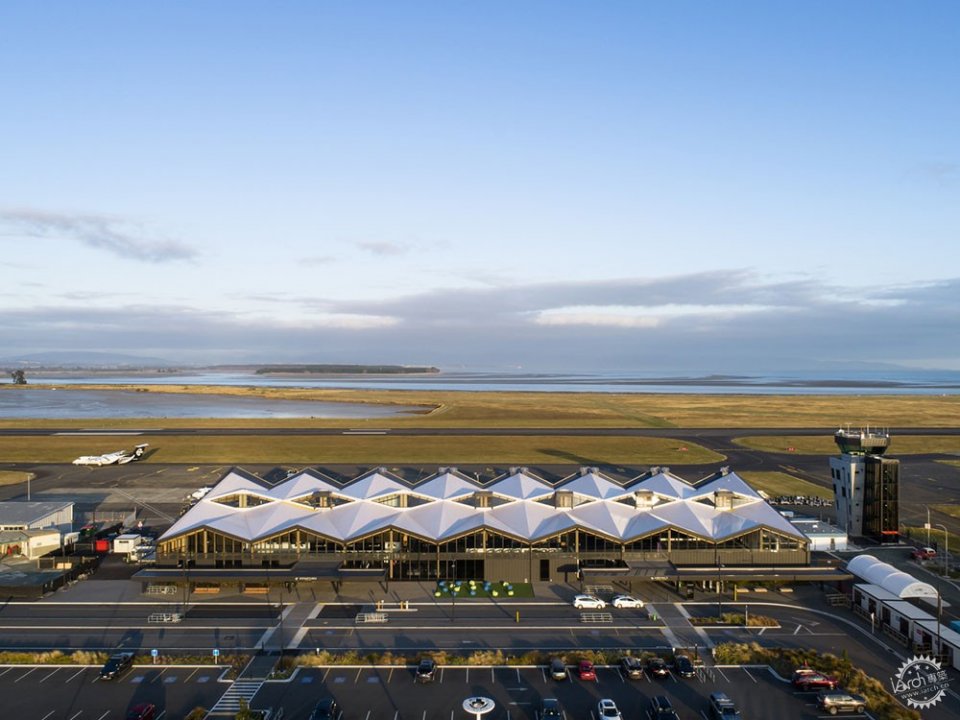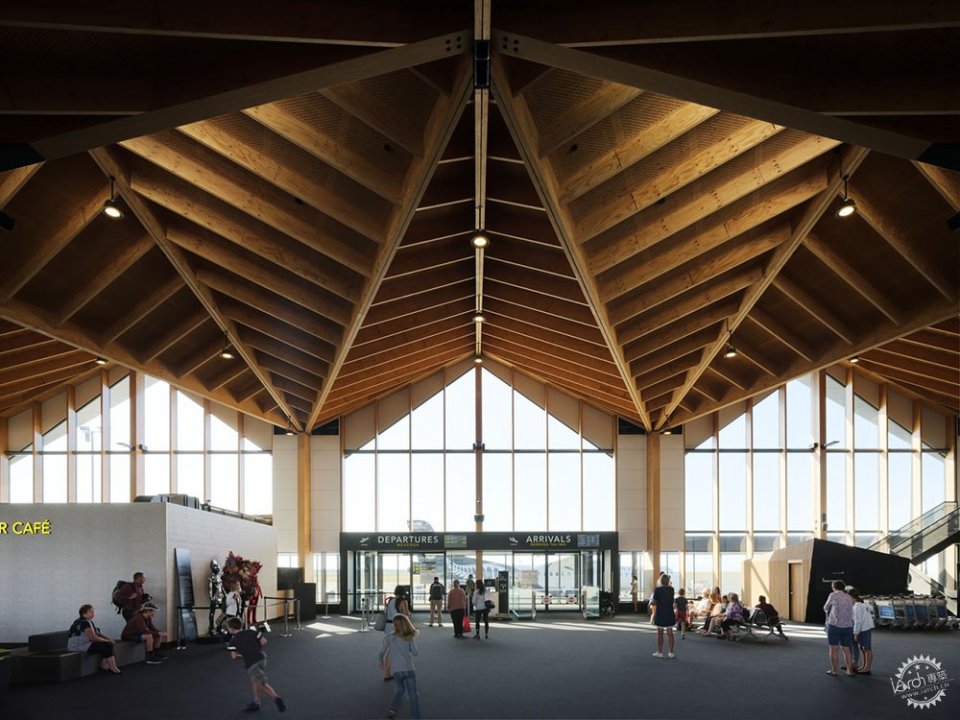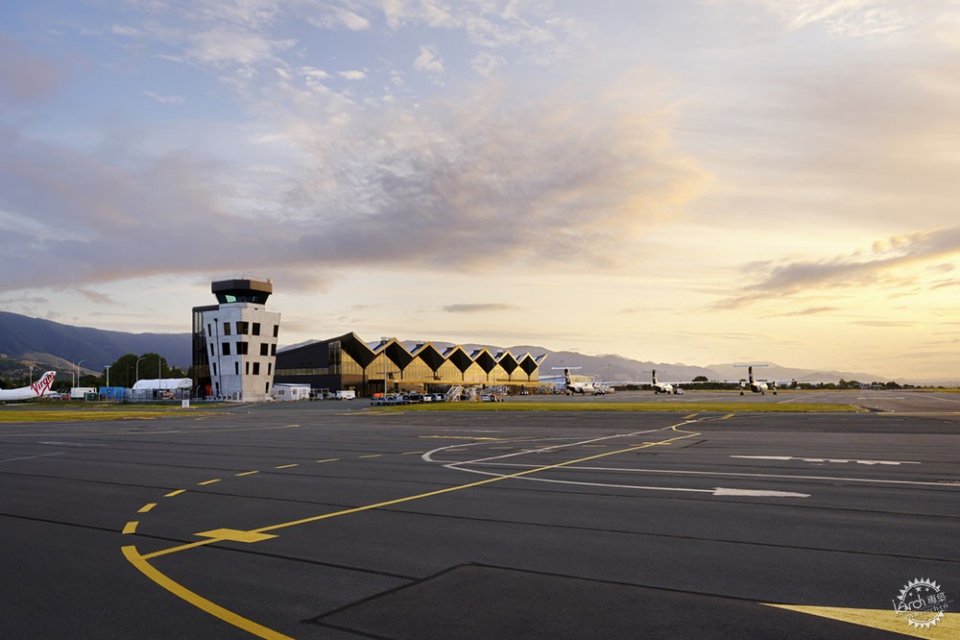
Nelson Airport Terminal / Studio Pacific Architecture由专筑网沈17,小R编译来自建筑事务所的描述。尼尔森机场航站楼是一座崭新的大跨度木构建筑,俯瞰机场跑道,背靠令人惊叹的塔斯曼湾和新西兰尼尔森的西部山脉。新机场航站楼的需求主要来源于原来于1975年落成的建筑不再符合现行的建筑规范要求,也无法应对持续增长的往返尼尔森旅客数量,因此新机场航站楼应运而生。Text description provided by the architects. The Nelson Airport Terminal is a new large span timber building overlooking the runway, with a stunning backdrop of Tasman Bay and the Western Ranges in Nelson, New Zealand. The requirement for a new terminal building arose out of the reality that the existing 1975 building no longer met building code requirements or functioned efficiently with the ever-increasing passenger numbers travelling through Nelson.

简明扼要地说,一座机场能够高效运转,同时作为交通枢纽和安全可行的商业区,更是反映了尼尔森不同寻常的特质,在建筑内部展示和景观的衔接,以及本地材料的延伸使用。设计者选择了两个主要策略传递对环境可持续设计的期望,即自然通风和使用大量木结构加上弹性的抗震结构解决方案的策略。The brief was for an airport that operated efficiently, both as a transportation hub and a safe and viable business, but also, aspirationally, one that reflected uniqueness to Nelson, connection to the landscape within the building, and extensive use of local materials. Two main strategies have been chosen to deliver on the expectation for an environmentally sustainable design; natural ventilation and the use of a mass timber structure coupled with a resilient seismic structural solution.

这些举措的利用使得尼尔森机场独树一帜,并为机场航站楼建筑的可持续运营树立了先例。建筑采用了简单却又复杂的方法为主航站楼空间实现了自然通风。建筑的平面、高度和屋顶形式的设计都尽可能地帮助空气流通,并在加热至屋顶高度的开口时充分利用空气浮力。低层的窗户将空气带入建筑,精心铰接的屋顶从建筑物中心断开,打造了能最大化日光射入量的天窗,并使热空气能通过玻璃百叶窗释放到室外。Utilisation of these initiatives enables Nelson Airport to differentiate itself and to set a precedent for the sustainable operation of an airport terminal building. The building takes a simple but sophisticated approach to achieve natural ventilation for the main terminal space. The building's plan, height, and roof form are designed to maximise air movement and to utilise the air’s buoyancy when heated to rise up to high-level openings. Low-level windows bring air into the building and the carefully articulated roof is split through the centre of the building, creating clerestory windows that maximise daylight and allow the release of hot air through glazed louvres.

沿着北立面,人字形的外顶棚有以下几个优势,它们充当空腔的作用,排放来自下部太阳能烟囱的热气,与此同时也为室内提供遮阳,减少北面的反光效果。相对于平面和立面的简单,屋顶看起来就非常复杂,给人极大的视觉冲击,并且以一种持续的、具有节奏感的方式折叠建筑长边,这也参考了周围环绕着的群山山脉。在内部,构成屋顶的木材结构最引人入胜的是自然的温暖质感、材质和尺度,令人流连忘返。Along the north façade, chevron-shaped external canopies have multiple benefits; they act as large chambers discharging warm air drawn in from the solar chimneys below, whilst also providing solar shading to the interior and reducing the extent of glazing to the north façade. In contrast to the simplicity of the plan and facade, the roof is highly complex and visually striking; folding across the length of the building in a constant, rhythmical pattern which references the surrounding mountain ranges. Internally the timber structure forming the roof is most captivating with natural warmth, texture, and scale that is an invitation to linger.

建筑师采用木材作为结构和形式表达的载体,和设计目的紧紧结合在一起,这是对设计主旨真实而可触的回应,也增强了物质性以及和四周环绕的森林的关联性,森林正是木材原材料生长的地方。重复的建筑模块构成了巨大却开放的平面布局,能使用最少数量的柱子实现灵活的室内平面布置,在这里,内部的“吊舱”漂浮在屋顶之下,满足建筑的使用需求。The use of timber as structure and form-giver is integral to the aims of the design - a true and tactile response to the brief, that reinforces the materiality and its connection and relevance to the surrounding forestry, from which it has been sourced. The repetitive building module achieves a large open footprint, allowing for flexible internal planning with minimal columns, where internal ‘pods’ float beneath the roof and house operational requirements, retail, and food and beverage offerings.

材料选择相对而言则简单得多,为了突出结构,并为内部的混合空间创造稳定的背景。这里作为进入尼尔森地区的主要入口,建筑以其形式和物质性传达了这个地方的本质。通过这种方式,尼尔森航站楼建筑是独一无二的,并以其地域性区别于世界上同类机场。The material palette is simple - stripped back to both highlight the structure and to create a calming backdrop for the mix of spaces within. As one of the main entry points into the Nelson region, the building expresses in its form and materiality the essence of the place. In this manner, the terminal building is unique and differentiated from homogeneous airports around the world through its regionalism.

建筑事务所:Studio Pacific Architecture类型:机场面积:5300 m2年份:2019年摄影:Jason Mann摄影工作室制造商:GRAPHISOFT, dormakaba, Godfrey Hirst, Santa & Cole, Thermosash, AGC Lighting, Adobe, Archicad, Architectural Roof and Façade Innovations Ltd (ARFI), Autex Industries, Autex PSL Alement, Cooper Webley, Horizon International Paving, Hush Panel, McNeel, Nelson Pine Industries ltd, Pacific Doors, Porcelanosa Wall Tiles, Roof Logic, Signwise, Streetscape NZ-1设计团队:Juliet Barker, Sarah Berry, Karl Frost, Simon Hardy, Evžen Novák, Dani Stevens, Laura Trama, Samantha Zondag委托人:尼尔森机场有限公司项目经理:Aesculus结构:Dunning Thornton Consultants Ltd服务:E-Cubed Ltd防火:Aurecon声学:Acoustic Engineering Services立面工程师:Mott MacDonald土木工程师:CGW Consulting Engineers工料测量师:Barnes Beagley Doherr Ltd零售租赁装修协调和浴室马赛克:Tile Artwork: Edito标牌设计:Studio Pacific Architecture、Edito景观:Studio Pacific Architecture主要承包商:Naylor Love in partnership with Gibbons Construction and Fulton Hogan城市:尼尔森国家:新西兰